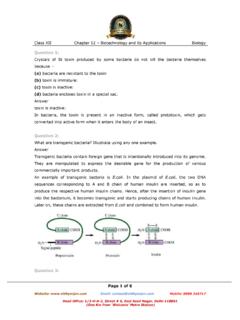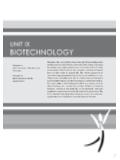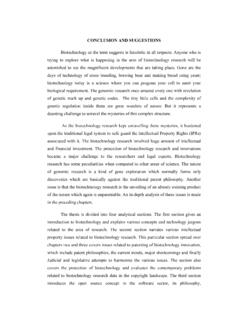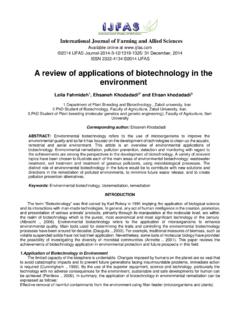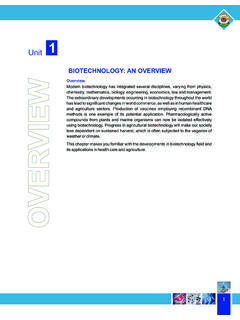Transcription of BIOTECHNOLOGY AND ITS APPLICATION TO VETERINARY …
1 Conf. OIE 2008, 231-240 - 231 - BIOTECHNOLOGY AND ITS APPLICATION TO VETERINARY SCIENCE Carlos G. Borroto Deputy Director, Center for Genetic Engineering and BIOTECHNOLOGY (CIGB), Havana, Cuba1 Original: Spanish Summary: A questionnaire was sent to the 29 Member Countries of the OIE Regional Commission for the Americas and information and comments were received from the Delegates of 21 Member Countries. The questionnaire covered aspects relating to the APPLICATION of BIOTECHNOLOGY to animal health, especially prevention-related issues, including: the development and production of medicinal products and vaccines; the use of metabolic modifiers, probiotics and prebiotics; advanced VETERINARY diagnostic methods; immunocastration and other applications . The questionnaire also covered the aspects of regulations and public perceptions.
2 The report analyses the situation in the countries of the region in relation to the state of the art in these technologies worldwide, revealing that modern BIOTECHNOLOGY -based technologies offer huge potential for the production of vaccines, medicinal products and other VETERINARY products. The development and use of these technologies is concentrated in a few countries of the region, while in others they are still not in widespread use. This creates the need to publicise and provide training in these technologies, for which suitable development conditions exist in a number of countries in the region. It is also necessary to foster the establishment of a comprehensive and effective regulatory framework for the safe use of these technologies from the dual standpoint of biosafety and of the regulations established in the VETERINARY register.
3 All the countries of the region consider that it is important for the OIE to issue additional standards for the production of VETERINARY products using modern BIOTECHNOLOGY . Key words: BIOTECHNOLOGY VETERINARY science Americas 1 Dr Carlos G. Borroto Nordelo, Sub-Director, Centro de Ingenier a Gen tica y Biotecnolog a, Av. 31 % 158 y 190, Rpto. Cubanac n, Playa, Marianao, La Habana, Cuba Conf. OIE 2008, 231-240 - 232 - Introduction A technical item on the APPLICATION of Genetic Engineering for Livestock and BIOTECHNOLOGY Products was presented and analysed at the 73rd General Session of the OIE in May 2005, based on the precept that modern agricultural BIOTECHNOLOGY applied to animal health and production is a fascinating mix of animal science, VETERINARY medicine and molecular biology.
4 On that occasion, the emphasis was placed on important issues such as regulations and public perceptions of applying BIOTECHNOLOGY to animal health and production, especially such controversial issues as animal transgenesis, cloning or xenotransplantation. Both the results of the questionnaire circulated for the technical item and the technical presentation itself provided important and extremely useful input for the work of the OIE and its Member Countries. For the upcoming Conference of the OIE Regional Commission for the Americas, the presentation and analysis will be on the APPLICATION of BIOTECHNOLOGY to animal health, especially prevention-related subjects such as the development and production of medicinal products and vaccines, immune boosters for farm animals and aquatic organisms (including metabolic modifiers, prebiotics and probiotics), advanced VETERINARY diagnostic methods, immunocastration, etc.
5 The questionnaire also covers the aspects of regulations and public perceptions. To obtain information from the member countries on this technical item, a questionnaire was circulated on the main issues involved. Answers were received from 21 Member Countries (Argentina, Barbados, Belize, Brazil, Canada, Chile, Colombia, Cuba, Dominican Republic, Ecuador, El Salvador, Guatemala, Guyana, Haiti, Honduras, Mexico, Panama, Paraguay, Trinidad and Tobago, United States of America and Uruguay). In a summary report such as this, it is not possible to cover the full range of potential BIOTECHNOLOGY applications to VETERINARY science. We have therefore selected a group of technologies with internationally-acknowledged real or potential impact whose use in the region should be promoted and regulated. The report has been divided into the following eight sections covering the state of the art and APPLICATION of these leading modern BIOTECHNOLOGY applications to VETERINARY science in relation to the region s current stage of development, based on the answers to the questionnaire: 1.
6 Research; 2. BIOTECHNOLOGY -derived VETERINARY vaccines; 3. Immunocastration; 4. Growth promoters and/or immune boosters; 5. VETERINARY diagnostic systems; 6. Prebiotics and probiotics; 7. Chief shortcomings of BIOTECHNOLOGY applications to VETERINARY science in each country; 8. Regulatory framework. Conf. OIE 2008, 231-240 - 233 - 1. Research Some countries in the region have a highly developed research capacity in this field, most of which is concentrated in Argentina, Brazil, Canada, Chile, Colombia, Cuba, United States of America, Mexico and Uruguay. These countries represent 43% of the countries that answered the questionnaire (see Figure 1). Figure 1. Is your country conducting research into animals and animal products, including vaccines and medicinal products that have been obtained using BIOTECHNOLOGY ?
7 A number of these countries even have research capacity in advanced fields such as genomics, proteomics and bioinformatics applied to VETERINARY science (see Figure 2). Figure 2. Is your country conducting research into animal genomics (including functional genomics, proteomics and bioinformatics? While it is true that the absence of major research activities in this field in more than half the countries in the region is not a favourable factor, the existence of these hubs of BIOTECHNOLOGY development applied to VETERINARY science opens up real opportunities for training, technology transfer and support for the development of infrastructure and specific projects in the region. 2. BIOTECHNOLOGY -derived VETERINARY vaccines It has been amply demonstrated that vaccination is the best available method for preventing economic losses in animals with a good cost/benefit performance.)
8 Nevertheless, several regions of the world, including our own, continue to suffer from serious diseases. Eight of the 10 leading causes of death in humans are attributed to infectious diseases. In animals, which have a shorter life span, the situation is even worse. Conventional vaccines have already been used for more than two centuries. They will continue to be used just as extensively in cases where they are the most effective vaccines available and will continue to be developed where appropriate in other cases. However, a number of different vaccines produced using BIOTECHNOLOGY are already in use and many more are at different stages of development. Their benefits include decreasing the risk of reversion to virulence of live vaccines and of interference with antibodies induced by passive immunisation, avoiding contamination with other viruses, reducing damage during storage and other aspects [1, 6, 13].
9 The great advantage of these vaccines is that they can be used in systems for differentiating infected from vaccinated animals (Differentiate Infected from Vaccinated Animals DIVA) [5]. As DIVA vaccines make it possible to differentiate vaccinated animals from animals exposed to virus strains, they allow diseases to be eradicated from a country much faster and more economically than by using conventional eradication methods. One of the first diseases to be successfully eradicated using the DIVA strategy was Aujeszky s disease. of countries General Animal sequencingPathogen sequencingFunctional genomicsVaccines Technology43%57% YES NO Conf. OIE 2008, 231-240 - 234 - BIOTECHNOLOGY -derived VETERINARY vaccines are being used not only to control infectious diseases, but also to increase productivity by modulating hormones or immune system functions, as well as for immunocastration, ectoparasite control, etc.
10 Of the countries in the survey, 76% produce or administer some sort of BIOTECHNOLOGY -derived vaccine, which is a significant step forward in the introduction of BIOTECHNOLOGY (Figure 3). Figure 3. Does your country produce or administer any animal vaccines obtained using BIOTECHNOLOGY ? As regards the technologies used, unfortunately only a quarter of the countries use at least one of the marker vaccines allowing differential diagnosis (Figure 4). Figure 4. Vaccine types An important aspect of these new technologies is their safe use and adequate public information about their nature and benefits, regulatory scrutiny of each technology and how the technologies are managed to reduce their potential risks to a minimum. Poor management of information for the general public and policy-makers can lead to failure or a ban on a product that is demonstrably safe and effective.










